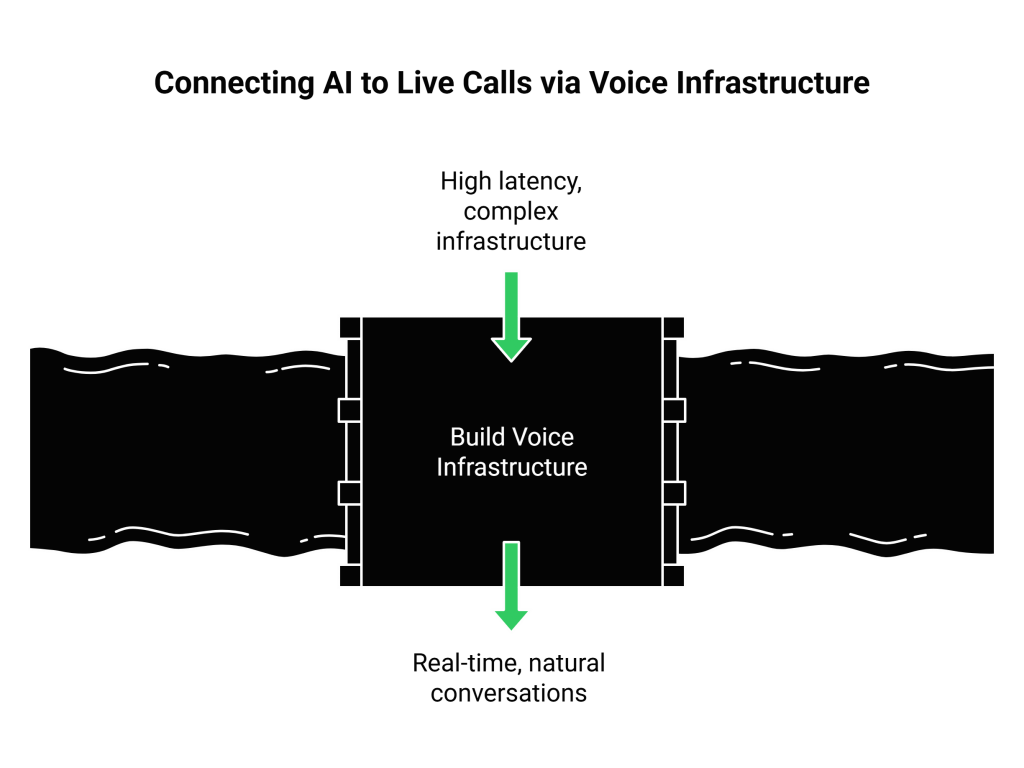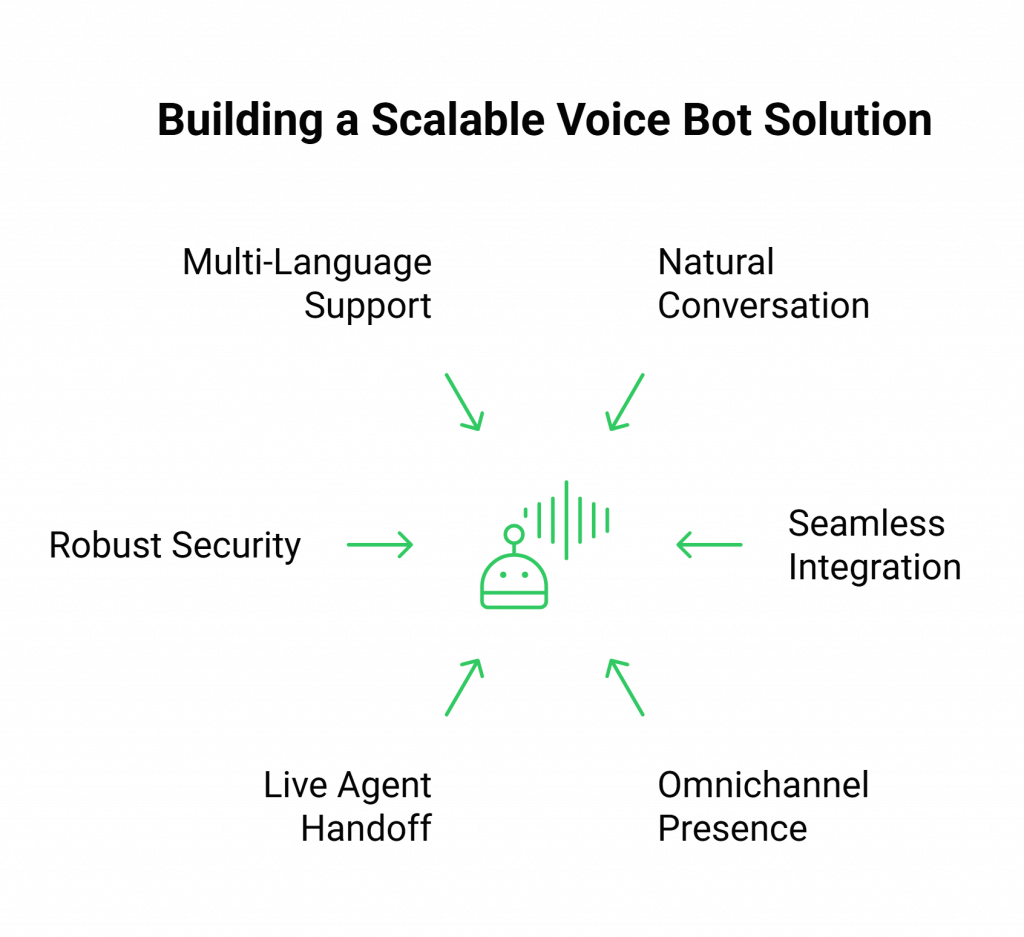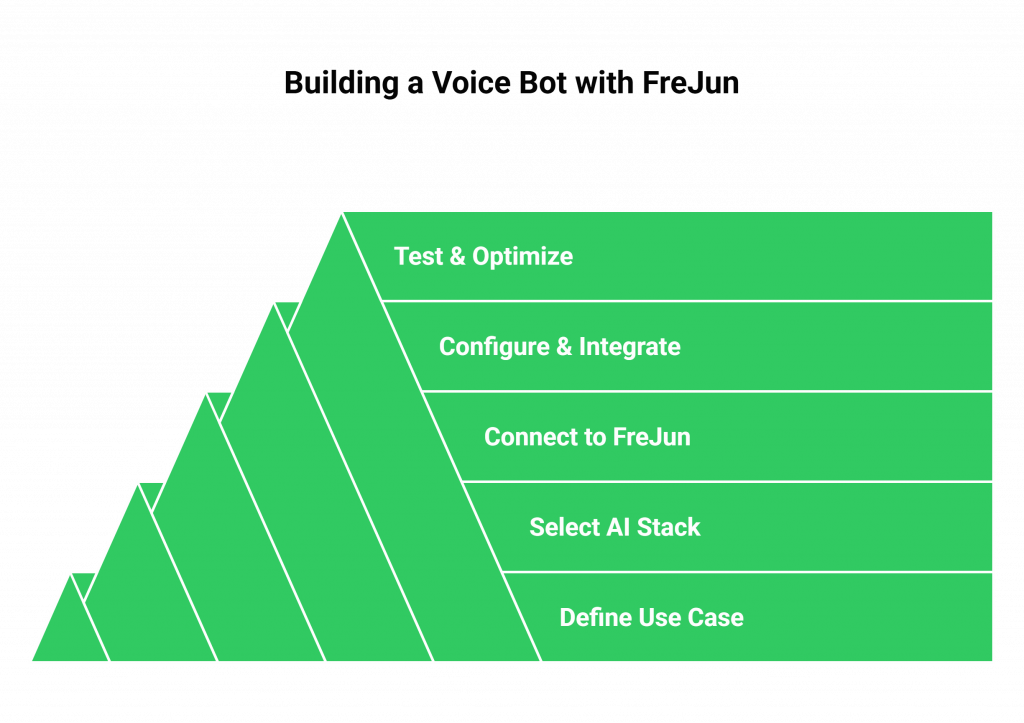Most enterprises have great AI for chat and automation, but their phone calls still rely on outdated systems. Customers are stuck in long menus, and teams waste time on repetitive calls. The real challenge is not the AI, it’s the voice infrastructure. That’s where FreJun helps. FreJun makes it easy to connect your AI to phone calls with low delay and high quality. This article shows how to build the best enterprise voice bot using FreJun’s powerful voice layer.
Table of contents
- The Enterprise Challenge: Moving Beyond Text-Based AI
- The Hidden Hurdle: Why Voice Infrastructure is the Real Bottleneck
- FreJun AI: The Infrastructure Layer for Your Voice AI Ambitions
- Anatomy of a World-Class Enterprise Voice Bot
- Building on FreJun vs. DIY: A Strategic Comparison
- How to Build the Best Voice Bot in 5 Steps with FreJun?
- Final Thoughts: Focus on AI, Not Infrastructure
- Frequently Asked Questions (FAQs)
The Enterprise Challenge: Moving Beyond Text-Based AI
Your enterprise has invested in powerful AI. Your chatbots can answer questions, your CRMs can track leads, and your internal systems are smarter than ever. Yet, your most critical communication channel, the phone call, remains largely untouched by this intelligence. Customers are stuck in rigid IVR menus, sales reps spend hours on manual qualification calls, and support teams are overwhelmed with repetitive queries.
You know the solution is a voice bot. But not just any voice bot. You need an intelligent, responsive agent that can handle complex conversations, understand customer intent, and integrate seamlessly with your core business systems. You need to build the best voice chatbot online for your specific enterprise use cases, from 24/7 customer support automation to proactive outbound sales campaigns.
The problem? Most enterprises believe the biggest challenge is choosing the right Large Language Model (LLM). While important, it’s only one piece of a much larger, more complex puzzle.
The Hidden Hurdle: Why Voice Infrastructure is the Real Bottleneck
You have selected a state-of-the-art AI model. You have a top-tier Speech-to-Text (STT) service to transcribe user speech and a Text-to-Speech (TTS) engine with a human-like voice, and you are ready to build.

But then you hit the wall. How do you connect your AI stack to a live phone call? How do you stream audio back and forth in real-time without the awkward, conversation-killing lag that frustrates customers?
This is the hidden hurdle: voice infrastructure.
Building and maintaining a low-latency, scalable, and reliable voice transport layer is a monumental engineering task. It involves:
- Managing Real-Time Media Streams: Capturing, transporting, and playing audio from global telephony networks with millisecond precision.
- Ensuring High Availability: Building geographically distributed, resilient infrastructure to guarantee uptime for mission-critical applications.
- Handling Telephony Complexities: Dealing with codecs, call signaling, carrier integrations, and global number provisioning.
- Minimizing Latency: Optimizing every component in the chain to eliminate the pauses that make AI conversations feel robotic and unnatural.
Attempting to build this from scratch diverts your most valuable resources,your developers and AI engineers, from their primary goal: building a great conversational experience. You end up spending months on plumbing instead of perfecting your AI’s logic and dialogue.
Also Read: WhatsApp Chat Handling Strategies for Medium‑Sized Enterprises in Jordan
FreJun AI: The Infrastructure Layer for Your Voice AI Ambitions
This is precisely the problem FreJun AI was built to solve. We believe that building the best voice bot should be about perfecting the AI, not wrestling with telephony infrastructure.
FreJun is a developer-first voice transport layer.
We handle the complex, real-time voice infrastructure so you can focus on building your AI. Our platform is architecture-designed for speed and clarity, providing the robust “plumbing” that connects your STT, LLM, and TTS services to any inbound or outbound call.
With FreJun, you bring your own AI. Our model-agnostic API allows you to plug in any AI chatbot or Large Language Model you choose, giving you full control over your bot’s logic, personality, and conversational flow. We manage the voice layer; you manage the intelligence.
Anatomy of a World-Class Enterprise Voice Bot
To build the scalable & best voice bot solution, you must combine your chosen AI with a set of essential capabilities. While your AI provides the brain, a platform like FreJun provides the reliable nervous system needed to deliver these features over a voice channel.

Core Capabilities Your Enterprise Voice Bot Needs
- Natural, Low-Latency Conversation: The gold standard is a conversation that feels human. This requires not only a great TTS voice but also an infrastructure engineered to minimize the delay between the user speaking and the bot responding. FreJun’s entire stack is optimized for this, eliminating awkward pauses.
- Seamless Integration with Business Systems: A voice bot operating in a silo is useless. It must connect to your CRM, helpdesk, and other enterprise systems to perform meaningful tasks like checking an order status, updating a customer record, or escalating a ticket. FreJun acts as the reliable channel that facilitates this data exchange during a live call.
- Omnichannel Presence: Customers should be able to interact with your AI across multiple channels, including phone calls, web chat, and messaging apps. A unified infrastructure ensures the conversational context can be maintained as users move between touchpoints.
- Flawless Live Agent Handoff: No bot can handle 100% of queries. The best voice bot knows when to escalate. This requires an infrastructure capable of seamlessly transferring the call,along with the full conversational context,to a human agent without forcing the customer to repeat themselves.
- Robust Security and Compliance: Handling voice data, especially in regulated industries like finance and healthcare, demands enterprise-grade security. This includes secure data handling, encryption, and compliance with privacy standards. FreJun is built with security by design at every layer.
- Multi-Language and Regional Support: To serve a global customer base, your bot must understand various languages and accents. This starts with capturing crystal-clear audio, a core function of FreJun’s media streaming, allowing your chosen STT service to perform at its best.
Also Read: Softphone Implementation Strategy for Remote Teams in Belgium
Building on FreJun vs. DIY: A Strategic Comparison
The decision of how to handle your voice infrastructure has massive implications for your project’s timeline, cost, and ultimate success. Here’s how building on FreJun’s dedicated transport layer compares to the do-it-yourself approach.
| Feature | Building with FreJun AI | Building Custom Voice Infrastructure (DIY) |
| Development Focus | On AI logic, dialogue design, and business process integration. | On telephony, media servers, latency management, and carrier relations. |
| Speed to Market | Days or weeks. Launch sophisticated voice agents quickly. | Months or years. Significant engineering effort required before AI work can begin. |
| Latency | Engineered for low-latency across the entire stack. | A constant, complex optimization challenge. |
| Reliability & Uptime | Built on resilient, geographically distributed, high-availability infrastructure. | Requires dedicated SRE/DevOps teams to build and maintain. |
| Scalability | Scale call volume on demand without managing servers. | Requires significant investment in infrastructure to handle peak loads. |
| Expert Support | Dedicated integration support from voice infrastructure experts. | Relies solely on internal expertise, which is often limited in this domain. |
| Core Competency | Lets you focus on what you do best: building intelligent applications. | Forces you to become an expert in a secondary field: telecommunications. |
How to Build the Best Voice Bot in 5 Steps with FreJun?
Using FreJun’s infrastructure abstracts away the hardest parts of launching your own online voice bot. Here is the streamlined path from concept to a production-grade voice agent.

Step 1: Define Your Enterprise Use Case
First, identify the specific process you want to automate. Don’t try to boil the ocean. Start with a high-impact area. Based on proven enterprise successes, common use cases include:
- Customer Support: 24/7 FAQ handling, order tracking, or intelligent call routing.
- Sales & Lead Gen: Qualifying inbound leads from marketing campaigns or automating appointment reminders.
- Finance & Banking: Automating balance inquiries, fraud alerts, or payment services.
- Internal Productivity: Automating HR onboarding questions or scheduling internal meetings.
Step 2: Select Your AI Stack (The Brains)
This is where you choose the “brains” of your operation. FreJun is model-agnostic, so you have complete freedom.
- Speech-to-Text (STT): Choose a provider that excels in your required languages and domains.
- AI/LLM: Select the model that best fits your use case. You might choose from platforms like Google Dialogflow, Amazon Lex, Kore.AI, or a custom-trained model.
- Text-to-Speech (TTS): Pick a service that provides clear, natural-sounding voices to represent your brand.
Step 3: Connect to FreJun’s Voice Transport Layer (The Nervous System)
Instead of building your own connection to the telephone network, you simply plug your AI stack into FreJun.
- Stream Voice Input: Use our API to capture the real-time, low-latency audio from any inbound or outbound call. This raw audio is streamed directly to your STT service.
- Process with Your AI: Your application receives the transcribed text, processes it with your LLM to determine the next action or response, and maintains full control over the dialogue state.
- Generate Voice Response: The text response from your AI is sent to your TTS service. You then pipe the resulting audio output back to the FreJun API, which plays it to the user in real-time.
Step 4: Configure and Integrate
With the core conversational loop in place, you can now connect it to your business. Use your backend logic to trigger actions based on the conversation:
- Pull customer data from your CRM to personalize the conversation.
- Create a ticket in your helpdesk system.
- Initiate a seamless transfer to a human agent if the bot detects frustration or a complex request.
Step 5: Test, Monitor, and Optimize
A voice bot is not a “set it and forget it” tool. Continuous improvement is essential.
- Performance Monitoring: Use analytics to track key metrics like call containment rates, handle time, and error rates.
- Conversational Analytics: Review conversation transcripts to identify areas where the bot struggles or where the user experience can be improved.
- Ongoing Training: Use real-world interaction data to continuously refine and train your AI model for better accuracy and more natural conversations.
Final Thoughts: Focus on AI, Not Infrastructure
The goal of enterprise automation is to create efficient, intelligent, and scalable systems that deliver a superior customer experience. Building the best voice bot is a direct path to achieving this, but the journey is fraught with technical complexity.
The most common mistake is underestimating the challenge of the voice infrastructure itself. By trying to solve the low-latency streaming and telephony problem in-house, companies inadvertently delay innovation and burn through their most valuable engineering resources.
FreJun AI offers a clear strategic advantage. We provide the robust, reliable, and scalable voice transport layer as a service. This frees your team to focus exclusively on what creates true competitive differentiation: the intelligence, personality, and effectiveness of your AI. Stop worrying about dial tones and start building the future of conversational AI.
Get Started with FreJun AI Today!
Further Reading – Remote Team Communication Using Softphones for SMB Success in Thailand
Frequently Asked Questions (FAQs)
No. FreJun AI is model-agnostic and serves as the voice transport layer. You bring your own AI, LLM, STT, and TTS services. This gives you complete control over the intelligence of your bot, while we handle the complex voice connectivity.
A voice transport layer is the infrastructure that manages the real-time streaming of audio between the public telephone network and your application. It handles capturing audio from a call, delivering it to your AI services for processing, and playing your AI’s audio response back to the caller with minimal latency.
Absolutely. FreJun streams clear, high-quality audio to your application. As long as your chosen STT and AI models support the desired languages, our platform provides the reliable channel needed for them to function effectively.
For a truly effective enterprise voice bot, you must integrate it with your core business systems. This typically includes CRM (e.g., Salesforce, HubSpot), helpdesk software (e.g., Zendesk), and internal ticketing systems. This allows the bot to perform meaningful, automated actions based on the conversation.
Yes. Seamless human agent handoff is a critical feature. The FreJun platform supports reliable call transfer capabilities, allowing your application to escalate a complex or unresolved call to a live agent, often with the full conversational context, for a smooth customer experience.
